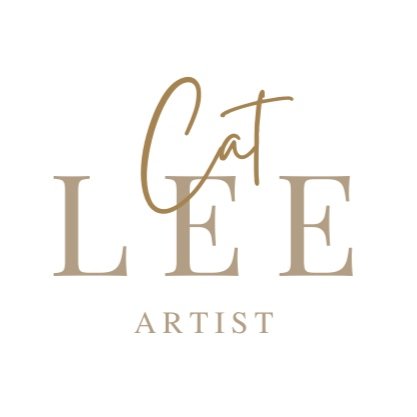'Ties That Blind' Art Show Review - Geoff Hands - "A Quick One?" - 17.03.18
Cat Lee: Ties That Blind
Onca Gallery, Brighton. (17-19 March 2017)
Phrases can be politically powerful and loaded – or just provide an effective shorthand of sorts in our daily lives. Trawling the media might provide a Phd student with pointers to the troubled collective unconscious in the current social climate – aided and abetted by consumer targeted song titles, advertising slogans, newspaper headlines and party political rhetoric (you know, all that Post-Truth truth). Good writers, and speechwriters especially, should avoid clichés of course – unless irony is intended. The double entendre (a British specialty) generally provides both mirth and sexual undertones: innocence is interchangeable with guilt; light becomes dark.
The titles of Cat Lee’s paintings exhibited in Ties That Blind at ONCA – “for one weekend only!” it has to be said, are loaded (or should I say, impregnated?) with various possibilities. Take the title of the show, (courtesy of listening to The Boss’ Ties That Bind) and look at some of the teasingly overt sexual imagery on display, and notions of forced role-play come to mind rather than positive familial and community ties that the Springsteen song eulogises. The culturally induced expectations, particularly of women, that render them as eye-candy for the male-gaze, provides an appropriate subject matter for a young female artist with an active feminist agenda to explore: but begs the question as to why audiences might need reminding of the pressures of appearance and behaviour that remain both insidiously and blatantly prevalent.
Cat Lee – Installation shot with ‘Equality In The Workplace’ (left).
Notwithstanding the third-wave (post?) feminist view that might claim empowerment through the twerking exploits of Miley Cyrus or Nicki Minaj – who provide entertainment for men and women alike – there’s still an argument that contorting the image of the body (physically and visually) remains an exploitative and degrading expectation that society generally purports to challenge. Part of Cat Lee’s mission is to present such disquiet through her painting practice – particularly in the largest painting in the show, ‘Religion and Righteousness’ (a triptych) – and even more so in ‘Equality in the Workplace’, which is painfully difficult to look at if such a pose were imagined. Linked to human rights and enlightened by some common understanding of a fair society, the expression of ‘equality in the workplace’ is in danger of becoming a truism if it remains no more than a well meaning, but dull statement, and actions fail to speak louder than words. This graphic image is shocking for the right reasons.
‘A Woman’s Worth’ (Alicia Keys?); ‘Fight or Flight’; ‘Theft’ and ‘Whoopsie!’ are some of the other titles of the paintings in this early career show. Some of the imagery appears to have been appropriated from pornographic sources, but a wider net is cast by depicting unnervingly, child centred, imagery from the cartoon characters that incongruously appear in some of the paintings, to provide disturbing juxtapositions. For example, ‘Sweetie Pie’, depicts two Tweety Pie portraits, with their yellow bulbous heads illuminating a pink-bikini clad, buxom blonde, staring creepingly at her body. Perhaps it is the rendering in spray paint that lends a wide-eyed wickedness to their presence? Likewise, ‘Just Keep Praying’ includes a drooling Winnie The Pooh with three sad, grey figures holding empty vessels before them.
Also undermining an innocent reading of the infant(ile) imagery are a kissing pair of Smurfs, appearing in ‘True Blue Love’, presented against a painterly abstract-like background, displayed with half a dozen other canvases in the basement section of the show.
What the twenty paintings (there are also two drawings on display) also have in common – in addition to the figurative subject matter – is a predilection for the painterly brush marks and vivid colours of gestural abstraction. Here the influence of the work of Marlene Dumas, Cecily Brown and Willem De Kooning is clear. The use of the ubiquitous spray paint (Brighton is awash with self-centred name-tags and crudely rendered cartoon imagery to affront or please the eye) also intervenes in Lee’s developing style and working process and lends a suggestion of ‘street art’ subversiveness into the mix.
Cat Lee – ‘Just Keep Praying’ (far left)
The most overt ‘abstract’ painting in the show is ‘Tripping’, wherein the near luminous psychedelic colour scheme dominates what appear to be graffiti-type body parts and three crudely rendered human faces. The dripping paint emphasizes the wall of colour on a surface that eschews visual perspective in favour of the abstract expressionist’s insistence on non-illusionistic imagery. As the drips flow in virtually all directions and the aforementioned heads are shown the right-way-up, diagonally placed and upside down, the steady gaze of the onlooker is also challenged.
Undoubtedly there is still work to do, with various avenues to explore on the blending of the imagery; with important decisions to be made whether to pursue the contrasting abstraction with the figurative imagery, or to drop one or the other; or to advance a knowing undermining of the tropes of abstraction (for example: autographic gesture, mark-making, colour and shape; formatted in to controlled aesthetic judgments and/or intuitive decision-making). But, as the opening comments reveal, there is much to be read into subject matter that remains current and vital – and will sustain a promising career.
This is just a fleeting show (less than three full days) but the now you see it – now you don’t format fortuitously suggests a peep into Cat Lee’s practice and leaves the viewer hungry for more.
Geoff Hands, March 2017



